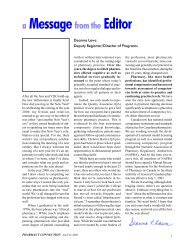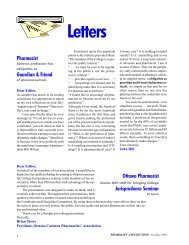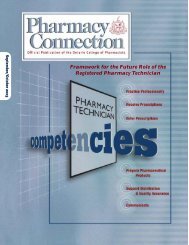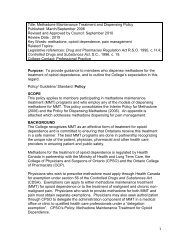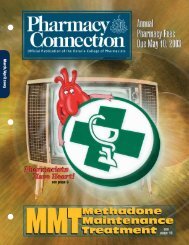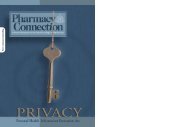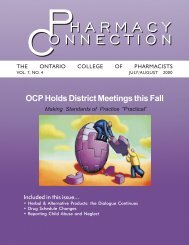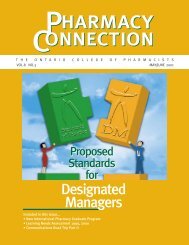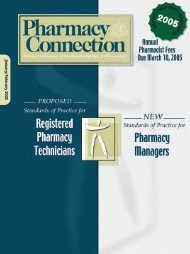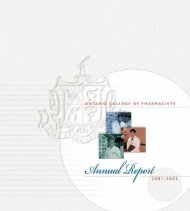July ⢠August 2003 - Ontario College of Pharmacists
July ⢠August 2003 - Ontario College of Pharmacists
July ⢠August 2003 - Ontario College of Pharmacists
Create successful ePaper yourself
Turn your PDF publications into a flip-book with our unique Google optimized e-Paper software.
COVER STORY<br />
Greg Ujiye, B.Sc.Phm.<br />
Manager, Pharmacy Practice Programs<br />
Regulation Now in Effect<br />
huge seizure and subsequent arrests across Canada, <strong>of</strong><br />
pseudo-ephedrine tablets destined for the U.S. for use in the<br />
illicit methamphetamine production.<br />
New Canadian Regulation<br />
Last year, the federal government created the Precursor<br />
Control Regulation under the Controlled Drugs and<br />
Substances Act (Regulation) to provide a regulatory framework<br />
that enables Canada to fulfill its international<br />
obligations and to address domestic concerns in monitoring<br />
and controlling access to precursors.<br />
Two classes <strong>of</strong> precursors, Class A and Class B, have<br />
been established. Class A precursors are essential components<br />
<strong>of</strong> illicit substances, such as methamphetamine,<br />
MDMA (ecstasy), cocaine, heroine, LSD, and PCP. Class<br />
B precursors are mostly solvents and reagents used in<br />
clandestine manufacturing processes. (See summary<br />
sheet for list <strong>of</strong> precursors and implementation schedule<br />
on page 14.)<br />
This regulatory framework will govern the international<br />
and domestic movement <strong>of</strong> precursor chemicals and will<br />
allow local and national law enforcement agencies, including<br />
Canada Customs and Revenue Agency, to identify and<br />
control illicit drug production and traffic.<br />
Implementation Dates<br />
A phased-in approach is being implemented: The licence and<br />
permit requirement for import/export <strong>of</strong> Class A precursors, as<br />
well as the licence requirement for their production, came<br />
into force on January 9, <strong>2003</strong>. Implementation controls over<br />
the domestic distribution <strong>of</strong> Class A precursors<br />
followed on <strong>July</strong> 7, <strong>2003</strong>, when the<br />
licence requirement to sell or provide came<br />
into force. Controls over Class B precursors<br />
will be effective on January 1, 2004.<br />
The intent <strong>of</strong> this Regulation is to reduce the diversion<br />
<strong>of</strong> precursor chemicals. It will also limit the ability <strong>of</strong> criminal<br />
organizations to legally purchase these chemicals as<br />
well as reduce the potential pressure on legitimate businesses<br />
from organized crime operators to sell these<br />
chemicals. At the same time, these controls will increase<br />
public safety and reduce the harm and risks to the environment<br />
that result from the clandestine laboratory operations<br />
that dump chemical wastes.<br />
Nonetheless, difficulties in upholding these regulations<br />
lie in the fact that most precursors have wide and legitimate<br />
uses in such common products as pharmaceuticals,<br />
fragrances, flavouring agents, petroleum products and<br />
paints. This Regulation enables Canada to address the need<br />
to monitor and control precursors, while at the same time<br />
remain sensitive and responsive to the approved uses <strong>of</strong><br />
these chemicals.<br />
Pharmacy Connection <strong>July</strong> • <strong>August</strong> <strong>2003</strong> 11



